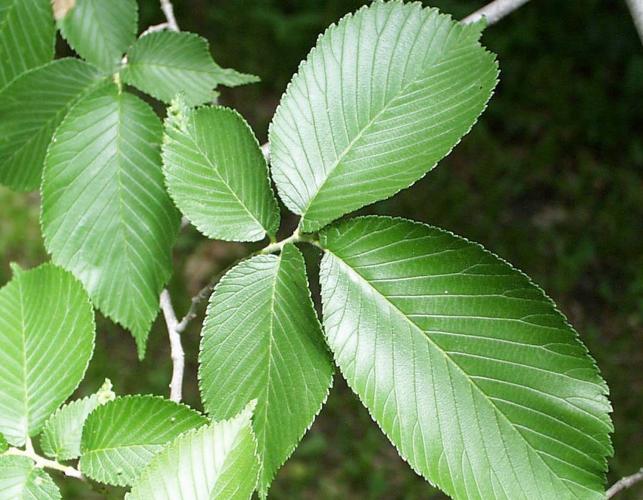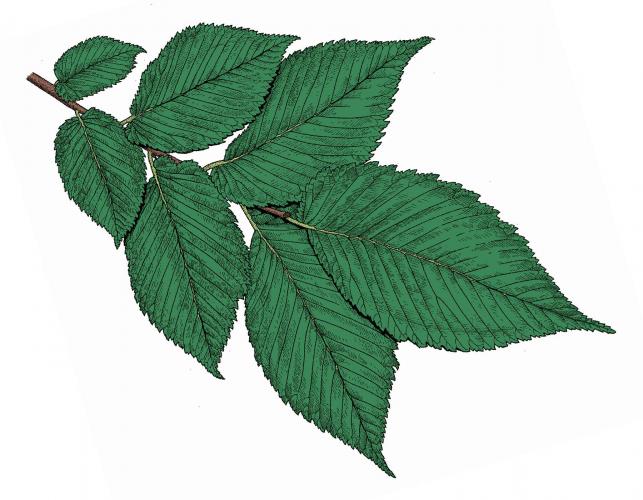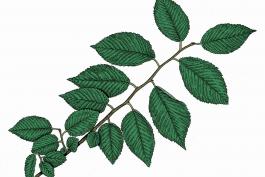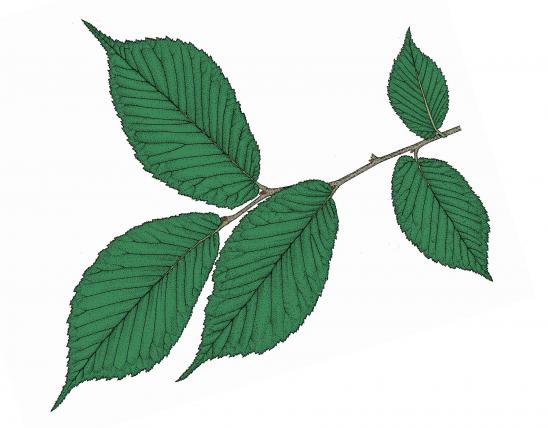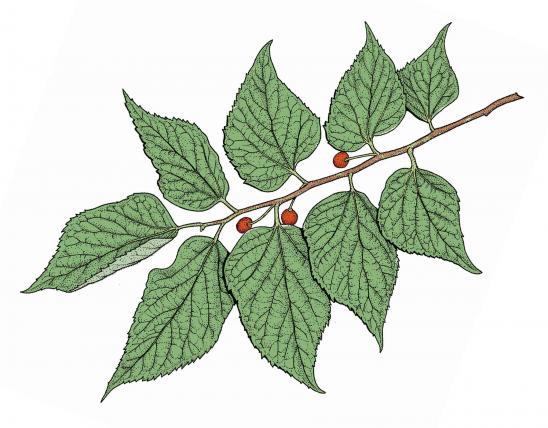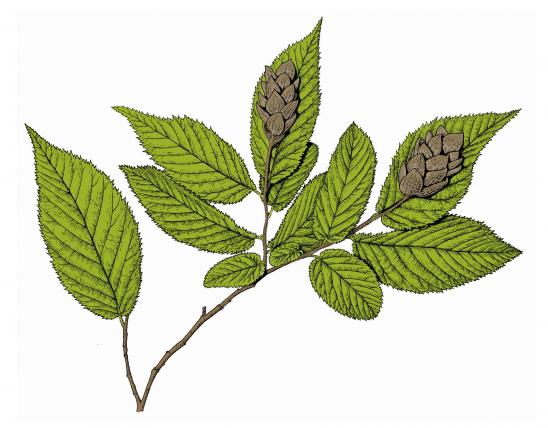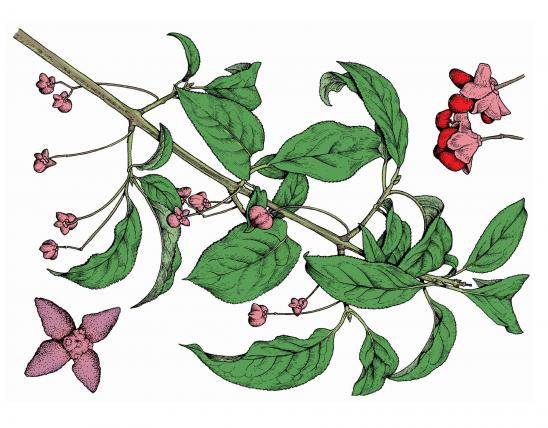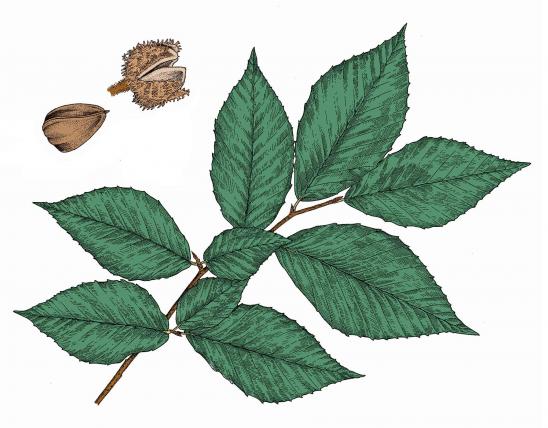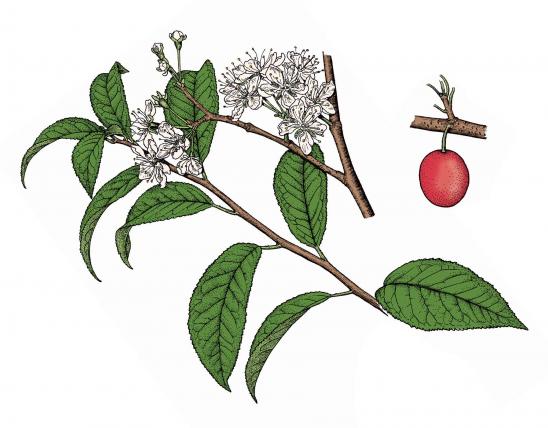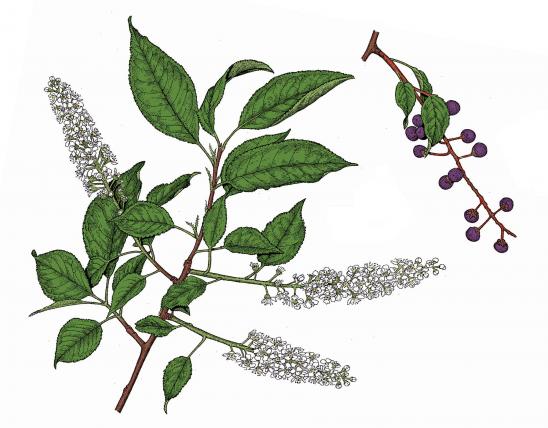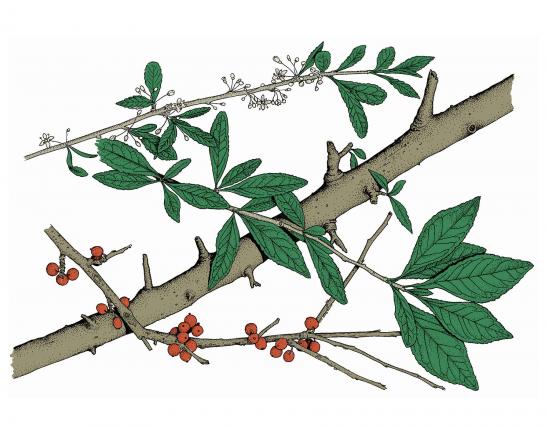
Missouri has several species of elms that you might find in natural settings, plus some that you could see in cultivation. Elms are famous for having tough, shock-resistant wood. In the past, some species were favorite shade trees, which is why so many towns have Elm Streets. But worldwide, elms have suffered this past century from a fungal disease transmitted tree-to-tree by beetles.
What do all elms have in common? First, realize that “elm” can refer, broadly, to the elm family (Ulmaceae) or, more strictly, to the elm genus (Ulmus). Here, we’re talking about the genus.
Elm leaves are alternate, simple, and serrated (toothed). Those traits, alone, aren’t very distinguishing, but look more closely: the margins are most commonly doubly serrated, with larger teeth alternating with smaller ones. Also, the base of an elm leaf blade is usually oblique and uneven, with one side of the blade not meeting evenly with the other side of the blade where it attaches to the leaf stalk. Finally, the tip of an elm leaf is usually acuminate, tapering to a long, sharp point, often concave along the sides of the taper. The upper leaf surface can range from smooth to strongly roughened. The lower surface is much paler than the top and is hairy or downy in most species. The veins, arising at an angle from the midvein, are mostly parallel and extend to the margin.
Elm flowers are not showy, though they usually grow in clusters. They lack petals, and wind blows the pollen from flower to flower. Most species bloom in the spring, although a few bloom in the fall.
Elm fruits are samaras (like ashes and maples, where the nutlet is enclosed in a flattened, papery wing). In elms, the samaras are circular or oval with a notch at the outer tip, with the nutlet positioned about in the center. The samaras have meshed veins; they start out green and become dry, tan, and papery at maturity, when they blow away in the wind.
The bark, in all our species, is fissured lengthwise in parallel ridges (note, however, that the nonnative Chinese elm has small plates that flake away, something like a sycamore’s bark).
The twigs are often somewhat zigzag; in some species they develop corky wings. Although some species never develop corky wings, the presence, absence, or amount of corky-winged twigs on any particular tree or branch is not a perfect key for identification. The winter buds have a variety of sizes and shapes (which helps ID the different species) and have several overlapping bud scales. The leaves are two-ranked on the twigs (in other words, although they are alternate, they are attached only on two opposite sides of the stem, not arising from it in a three-dimensional spiral).
Elms can be tricky to identify to species, and even professional botanists insist on seeing flowers, fruits, or both in order to be certain. Species distinctions are difficult to make by leaves and twigs alone. Also, confusing things more, several species of elms can hybridize with each other, creating offspring that have characteristics intermediate between the two parent species.
There are about 40 species of elms worldwide. Missouri has seven elm species that might be encountered in natural settings:
- American elm (U. americana), also called white elm. America’s most famous elm. Scattered nearly statewide. Until Dutch elm disease came to America, this large, graceful species was widely planted along city streets and was beloved as the all-American shade tree. At maturity, lines of these trees, with their distinctive fan-shaped or goblet-shaped crowns arching over a street, made welcoming tunnels of green for drivers and pedestrians. Now large specimens are rare, since the deadly fungus usually kills trees before they reach fine old ages. Today, American elm survives because even young trees can produce viable seed. However, as new trees grow, they eventually succumb to the disease and die before they get very big.
- Siberian elm (U. pumila). Introduced to Missouri; native of Europe and Asia. Occurs sporadically, relatively common in far southwest and far northeast Missouri and in the St. Louis region. Occurs in a wide variety of habitats, including forests, prairies, streambanks, old fields, fencerows, cemeteries, gardens, roadsides, and other disturbed areas. Introduced to the United States in the middle 1800s, Siberian elm pays for its fast growth with brittle wood that is subject to storm damage. Its large limbs are subject to splitting from the crotches of older trees. Most trees now growing in urban and suburban areas were not planted but have merely been allowed to grow by homeowners unaware of the wood’s brittle nature.
- Slippery elm (U. rubra; formerly U. fulva); also called red elm. Found nearly statewide. This is the most abundant species of elm in Missouri. Slippery elm has fuzzy twigs and reddish hairy buds, which often attract attention in wintertime. Its inner bark is reddish and very slimy, which gives this tree both of its common names. Native Americans had many uses for this species, and slippery elm bark is still used medicinally to soothe sore throats, for treating colds, and in other applications.
- Winged elm (U. alata), also called wahoo. Scattered mostly south of the Missouri River. Usually occurs as a shrub or small tree in dry upland areas, but when it grows in bottomlands it can grow large enough to be a mid-story or canopy tree. In wetter habitats, this species tends to develop fewer corky branches. But usually, the corky wings that form on the young branches and twigs of this species are quite noticeable, more so than the corky wings that form on several other elms.
- Rock elm (U. thomasii), also called cork elm. Uncommon in the northern and central portions of the state; the overall range includes much of eastern North America, especially states and provinces to our north and east. Its leaves and buds resemble those of American elm. Its corky wings are (usually, but not always) narrower than those of winged elm; also, it generally has larger leaves and longer leaf-stems than winged elm. Its wood is considered to be the highest quality of all our elms, and in the past, it was extensively logged. Named rock elm because it frequently occurs on limestone outcrops and bluffs with little soil.
- Cedar elm (U. crassifolia). Uncommon in Missouri, known so far only from Butler County; its overall range is to our south and east. Our only elm that has the leaf blades angled to a broadly or bluntly pointed tips (instead of having the leaves tapered to a sharp point); also, it flowers and fruits in the fall instead of in the spring.
- English elm (U. minor). Introduced, uncommon, sporadic in Missouri; a native of Europe. In Missouri, this elm has been found sporadically in edges of glades and upland prairies and in open, disturbed areas. The story of this species is much like that of American elm: Although historically it was a great, majestic, and economically important tree characteristic of western European forests, Dutch elm disease has reduced it so that it now mostly occurs as low thickets of suckers.
Similar species: Several species are similar to elms, including their close relatives in the elm family. Also, there’s Chinese elm, an elm species that is common in cultivation, but hasn’t yet been recorded in natural settings:
- Chinese elm (U. parvifolia) is widely cultivated in Missouri but is apparently not known outside of cultivation in our state. It is very similar to Siberian elm but it has different bark. The bark of Chinese elm is not furrowed; instead, it peels off as irregular woody scales to about 1½ inches wide, and the bark is orangish brown where it is freshly exposed, weathering to ashy gray. Also, Chinese elm flowers and fruits in the fall instead of in the spring.
- Water elm (Planera aquatica) occurs in swamps and low, wet bottomland forests in Missouri’s Bootheel. It’s in the elm family, but not in the same genus as the others. It’s a large shrub or small tree to 40 feet tall. Its flowers are in clusters of 2–5 and lack petals. Its fruits really set it apart from “true” elms: the fruits are about ⅜ inch long, leathery nuts that are covered with an irregular, warty or prickly surface (not winged samaras as in other elms). This is the only member of its genus; its closest relatives are extinct and known only from fossils.
- Hackberries (Celtis spp.) have leaves that are rather similar, and they have sometimes been placed in the same family as elms. Hackberries have fleshy, berrylike fruits (technically drupes) instead of winged seeds. They also develop corky, warty projections from their bark. Missouri has three species: common hackberry (C. occidentalis), sugarberry (C. laevigata), and dwarf hackberry (C. tenuifolia).
- Several other Missouri trees have alternate, simple, toothed leaves, including hazelnuts, hornbeams and hop hornbeams, hawthorns, plums, cherries, beeches, hollies, persimmon, and more. The flowers and fruits are usually a greater help in plant identification than leaves.
- Finally, eastern wahoo (Euonymus atropurpureus) should not be confused with winged elm (U. alata), which is sometimes also called “wahoo.” The two are unrelated.
Height: about 6–115 feet; varies with species. The size of most of our species is limited by their short lifespans due to Dutch elm disease.
Statewide. Different species have different distribution patterns within the state.
Habitat and Conservation
Elms live in a variety of habitats. Different species have their own preferred habitats. Often, a species that commonly occurs along streams in low, moist areas may also live in drier, upland areas, but in a smaller form.
Dutch elm disease (DED) is a nonnative tree-fungal infection that spread across North America in the middle of the 20th century, and it’s been present ever since. All our native elm species are impacted by the fungus that causes the disease.
It’s called Dutch elm disease because the botanists and plant pathologists who first described it (in the 1920s) were from the Netherlands; the disease apparently was first imported to Europe from Asia. It was first noted in Europe in 1919.
When DED swept through America at midcentury, it left millions of huge American elms — lining countless streets, in people’s yards, in parks and cemeteries, lining our big rivers, and in our natural woodlands — dead and dying in its wake.
DED is caused by a genus of wilt fungi, Ophiostoma spp., which enters an elm tree when an unwitting beetle (usually one of a few species of elm-bark beetles, Scolytus spp.), carrying the fungal spores on its body, chews into the trunk or limbs. The fungus invades the vascular system of the tree, and the tree forms tyloses (something like a scarlike tissue) as a defense against the fungal infection. The tyloses become so numerous they block the flow of sap along the trunk, and the tree dies.
At this point, globally, there are several strains of Ophiostoma fungus; some strains are especially virulent and devastating, and there’s no sign of this tree-pandemic waning.
Researchers are working to develop DED-resistant cultivars of elms, especially American elm. Some species of elms in Asia appear to be fairly resistant to the fungus. Fortunately for our elm species, they can reproduce as a relatively young age, before they die from DED.
Human Connections
Because elm wood is hard and strong, it is used for furniture, fenceposts, flooring, and general construction. It is also used as a veneer for other woods. In the past, it was widely used for making wheel hubs, saddle trees, ship’s hulls, and agricultural and kitchen implements — uses where its hardness and flexibility are especially valuable. Its wood grain is interlocked and is difficult to split, making it especially suitable for items that require bending, such as hockey sticks or curved pieces in furniture.
Elm bark has had a variety of uses, too. It is used for tanning leather. Elms were once widely used for construction of bark canoes, and fiber from elm bark has been used in the past to make ropes, cords, and roofing felt.
Elm foliage was long used as fodder for livestock in Eurasia, and it is still important for this purpose in northern India.
Slippery elm, with its mucilaginous bark, had many uses among Native Americans, who used it in a medicinal tea, a food preservative, cordage, and building material. Slippery elm bark is still used medicinally by many people, and it is among the natural products that is wild-harvested, particularly in the Ozarks, and is sold by individuals to wholesale distributors.
Elms are very widely grown as street trees and shade trees, but their use has been limited by Dutch elm disease. Older Missourians can remember what streets used to look like with dozens of majestic elms gracefully arching their branches overhead. They can also remember the great die-off, as these trees almost all succumbed to the disease. Researchers have been working to develop disease-resistant strains of popular elm species, particularly American elm.
Some perspective: The great dying of millions of beloved, majestic elms in the mid-20th century was traumatic for Americans. Not long before that was the chestnut blight, which killed millions of large, venerable, valuable American chestnut trees. Today, Americans are being traumatized by the wholesale loss of our ash trees, caused by the invasive, nonnative emerald ash borer. The various species of elms have been able to survive Dutch elm disease because the trees can reproduce at a young age, before they are killed by the fungus. But unfortunately for the ashes (indeed, all our native ash species), the emerald ash borer kills even young trees, before they can set seed. This sets the stage for the complete disappearance of ash trees.
Dutch elm disease, chestnut blight, and the emerald ash borer are cautionary history. There are many more nonnative, invasive pests and plant diseases that threaten the trees and forests of North America. The USDA Animal and Plant Health Inspection Service (APHIS) and the combined forces of state agriculture, conservation, forestry, and university extension departments track forest threats, educate the public, and work to fight off pests and diseases should they appear.
Because elms are generally rather difficult to identify to species, many people are content to refer to any member of the genus as simply “an elm” and leave it at that. We don’t blame them.
If you’re interested in linguistics, you might find it impressive that our word elm and the genus name Ulmus both have very ancient roots that trace back through English, Germanic, and Latin forms. The Italian and Spanish word for it is olmo; in French, it’s orme; in German, Ulme; in Danish, alm. With its form virtually unchanged across many centuries, the word elm seems always to have meant “elm.”
English elm, in its native Europe, was historically used as a support for grape vines. The vines were planted near young elm trees and were trained to climb on the trees, which were pollarded and trimmed to be the perfect size to hold the vines.
Ecosystem Connections
The seeds and buds of elms are eaten by deer; squirrels, chipmunks, and other rodents; and by many species of birds, including upland game birds like prairie-chicken and turkey and songbirds such as chickadees, goldfinches, and more.
Passenger pigeons, before being hunted to extinction, were major consumers of elm nutlets.
Deer and rabbits browse the leaves. Beavers gnaw on the bark and wood.
Many types of insects feed on elms, including many that prefer or are even limited to elms as their food plants. Among the insects that are commonly found on elms are:
- The caterpillars of several butterflies and moths, such as the comma and question mark and the elm sphinx and double-toothed prominent, the latter a particularly handsome moth
- The fat, grublike larvae of the elm sawfly
- Many, various types of aphids
- Many, various types of leafhoppers
- Several types of plant bugs
- Walkingsticks
- Several kinds of leaf beetles chew the leaves, particularly the elm leaf beetle (Xanthogaleruca lutea) and large elm leaf beetle (Monocesta coryli).
- Certain elm bark beetles are unwittingly responsible for transmitting Dutch elm disease from tree to tree, especially species Hylurgopinus rufipes and Scolytus multistriatus.
- Several types of longhorned beetles bore into the wood, including the elm borer (Saperda tridentata), a gray beetle with orange stripes. This species can transmit the Dutch elm disease, but it is not a primary transmitter.
Do elms seem like a bonanza for bugs? Keep in mind that most birds — even ones that eat seeds and berries at other times of the year — require insects during nesting time, for the added protein. A tree that feeds insects indirectly feeds the birds.
Dutch elm disease isn’t the only insect-transmitted disease faced by elms. One type of leafhopper, the white-banded elm leafhopper (Scaphoideus luteolus), transmits a viral disease called elm phloem necrosis, or “elm yellows,” from elm to elm.
Elms, like other trees, have their own suite of fungi, including the familiar mica caps and velvet foot mushrooms. Morels are also associated with elms (in addition to ashes, apple trees, and several other species); their fungal networks connect with the roots of trees in a mutualistic relationship. When you are hunting morels in spring, make sure to look under dying elms.
Speaking of rotting wood, fallen trees become a habitat and food source for numerous organisms: insects, pillbugs, centipedes, salamanders, and so on.
Overhead, elms provide habitat for organisms ranging from mosses and lichens to spider webs, bird nests, and squirrel homes.
